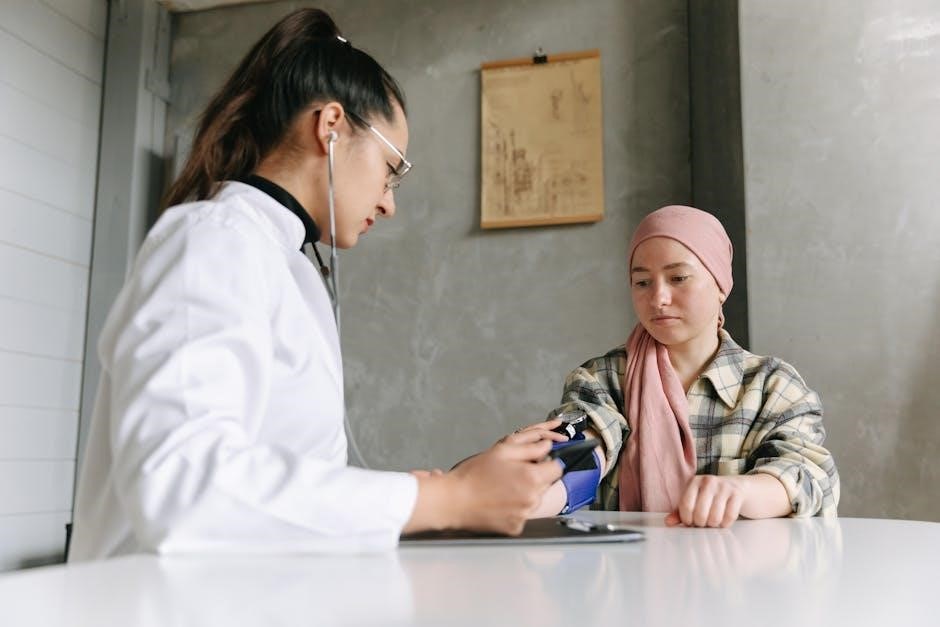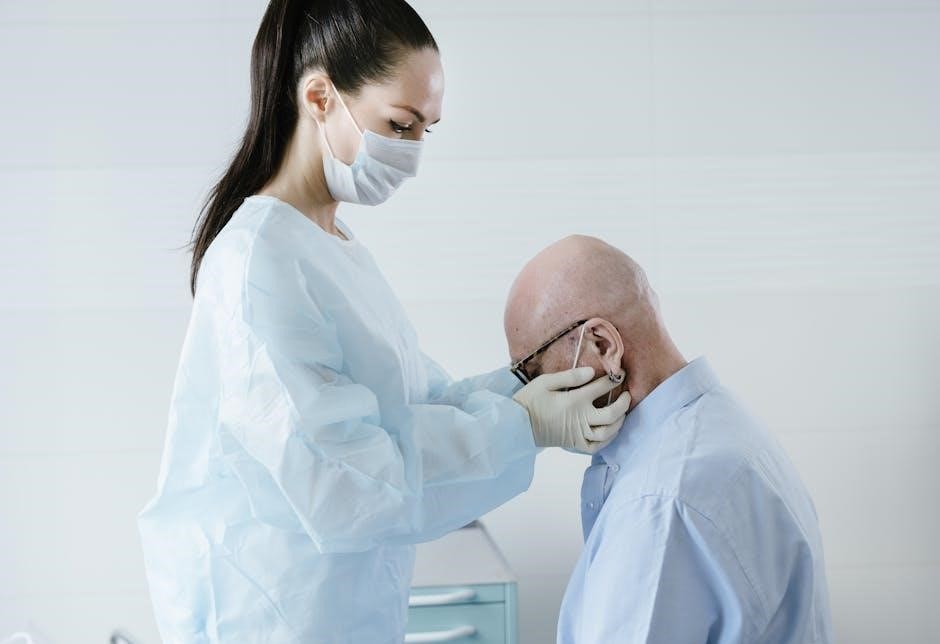A head-to-toe assessment is a systematic, comprehensive evaluation of a patient’s physical condition, gathering vital data to guide care planning and ensure patient safety and well-being.
Overview of the Head-to-Toe Assessment Process
The head-to-toe assessment is a structured, systematic process used by nurses to evaluate a patient’s physical condition. It begins with initial patient interaction, ensuring privacy and comfort, followed by measuring vital signs such as temperature, pulse, respirations, blood pressure, and pain. The nurse then observes the patient’s general appearance, noting factors like hygiene, posture, and mobility. The physical assessment proceeds sequentially, examining each body system, including the integumentary, HEENT (head, eyes, ears, nose, and throat), neck, thoracic spine, cardiovascular, respiratory, abdominal, genitourinary, musculoskeletal, and neurological systems. Each assessment involves inspection, palpation, percussion, and auscultation as appropriate. Findings are documented in a structured format, often using a nursing assessment summary table, to communicate effectively with the healthcare team. This process ensures a thorough and organized approach to patient care, identifying abnormalities and guiding interventions. It is a foundational skill for nurses, essential for delivering high-quality, patient-centered care.
Importance of a Comprehensive Assessment in Nursing Practice
A comprehensive head-to-toe assessment is foundational in nursing practice, enabling nurses to identify potential health issues early, prevent complications, and tailor care to individual patient needs. It ensures a thorough evaluation of all body systems, promoting holistic patient care. By gathering accurate and detailed data, nurses can detect subtle changes in a patient’s condition, facilitating timely interventions. This process also enhances decision-making, allowing nurses to prioritize care effectively and communicate findings clearly to the healthcare team. Regular assessments aid in monitoring progress, identifying red flags, and adjusting care plans as needed. Additionally, they support legal and ethical standards by maintaining detailed records of patient status. Ultimately, a comprehensive assessment improves patient outcomes, ensures safety, and upholds high-quality care standards in clinical settings. It is an essential skill for nurses, fostering critical thinking and clinical judgment in daily practice.

The General Survey
The general survey begins with initial patient interaction, ensuring privacy, and assessing vital signs. It involves observing general appearance, hygiene, and overall patient condition to guide further assessment.
Initial Patient Interaction and Privacy Measures
Initial patient interaction begins with a polite greeting, introducing oneself, and explaining the purpose of the assessment. Ensuring patient privacy is paramount, achieved by closing doors or curtains. Patients should be informed of the process and consent obtained. A calm and professional demeanor helps establish trust. Key considerations include respecting patient autonomy, maintaining confidentiality, and addressing any anxiety. Proper draping and positioning ensure dignity throughout the assessment. Effective communication skills, such as active listening, are essential. Cultural sensitivity and awareness of individual needs are also vital. The environment should be comfortable, with adequate lighting and minimal distractions. Privacy measures are upheld during the entire process, adhering to ethical standards and legal requirements. These steps set the foundation for a thorough and respectful head-to-toe assessment.
Assessing Vital Signs (Temperature, Pulse, Respirations, BP, Pain)
Assessing vital signs is a critical component of the head-to-toe evaluation, providing baseline data on the patient’s physiological state. Temperature is measured using an oral, tympanic, or axillary thermometer, with normal ranges typically between 97.7°F and 99.6°F. Pulse is evaluated for rate, rhythm, and strength, usually between 60-100 beats per minute; Respirations are observed for rate (12-20 breaths per minute) and depth, noting any irregular patterns. Blood pressure is measured using a sphygmomanometer, with normal readings typically below 120/80 mmHg. Pain assessment involves asking the patient to rate their discomfort on a 0-10 scale and identifying its location, character, and duration. These measurements are recorded accurately and compared to previous data to detect trends or abnormalities. Proper technique ensures reliable results, which are essential for guiding care decisions and monitoring patient stability. Attention to detail and patient comfort during the process are equally important.
Observing General Appearance and Hygiene
Observing a patient’s general appearance and hygiene provides valuable insights into their overall health and well-being. This step involves assessing grooming, posture, facial expressions, and signs of distress or illness. Noting factors such as cleanliness, body odor, and nail care can indicate self-care abilities or potential neglect. The nurse should also evaluate the patient’s mobility, noting any limitations or assistive devices used. Skin integrity is assessed for signs of breakdown, rashes, or lesions. Hair and scalp condition, as well as oral hygiene, are also examined. These observations help identify potential health issues, such as malnutrition, dehydration, or infection. Documenting these findings aids in developing a personalized care plan and ensures continuity of care. A thorough observation of general appearance and hygiene lays the foundation for a comprehensive head-to-toe assessment.

Physical Assessment of Body Systems
The physical assessment evaluates major body systems, including integumentary, cardiovascular, respiratory, abdominal, genitourinary, musculoskeletal, and neurological systems. Techniques like inspection, palpation, auscultation, and percussion are used to identify abnormalities, ensuring holistic patient care.
Integumentary System Assessment
The integumentary system assessment involves evaluating the skin, hair, nails, and mucous membranes for integrity and function. Nurses inspect the skin for color, texture, and any lesions or abnormalities, such as rashes, bruises, or scars. Palpation is used to assess skin temperature, turgor, and elasticity, while also checking for areas of pain or swelling. Hair and nails are examined for signs of health or disease, such as dryness, brittleness, or discoloration. Mucous membranes, including the oral cavity, are inspected for moisture, color, and integrity. This assessment helps identify issues like dehydration, infection, or nutritional deficiencies. Documenting findings ensures comprehensive care and timely interventions, such as wound care or referrals for further evaluation. Abnormalities like jaundice, cyanosis, or edema are red flags requiring immediate attention. A thorough integumentary assessment is vital for maintaining patient health and preventing complications.
Head, Eyes, Ears, Nose, and Throat (HEENT) Assessment
The HEENT assessment evaluates the head, eyes, ears, nose, and throat for abnormalities. Inspect the head for lumps, lesions, or trauma. Assess eye vision, pupils, and conjunctiva for redness or discharge. Use an otoscope to examine the ears for signs of infection or wax buildup. Check hearing with whisper or tuning fork tests. Inspect the nose for congestion or discharge and palpate the sinuses for tenderness. Examine the throat for redness, swelling, or exudate, and assess swallowing ability. Document any abnormalities like vision changes, hearing loss, or nasal congestion. Abnormal findings may indicate infections, allergies, or neurological issues. This assessment helps identify conditions requiring immediate intervention, such as sinusitis or otitis media. Accurate documentation ensures comprehensive care and timely referrals if needed.
Neck and Thoracic Spine Assessment
The neck and thoracic spine assessment involves evaluating for signs of injury, deformity, or dysfunction. Inspect the neck for swelling, asymmetry, or distended veins. Palpate the cervical lymph nodes for enlargement or tenderness. Assess the range of motion by having the patient flex, extend, rotate, and lateral flex the neck. Check the thoracic spine for curvature abnormalities, such as kyphosis or scoliosis. Palpate the spinous processes for tenderness or muscle spasms. Document any limitations in movement or pain during the assessment. Common abnormalities include cervical lymphadenopathy, limited range of motion, or signs of spinal misalignment. These findings can indicate musculoskeletal issues, infections, or neurological conditions. Accurate documentation aids in early detection of potential problems and guides further diagnostic or therapeutic interventions. This assessment is crucial for ensuring proper spinal alignment and detecting abnormalities that may impact patient mobility or comfort.
Cardiovascular Assessment
The cardiovascular assessment evaluates the heart and blood vessels to identify signs of dysfunction or disease. Begin by inspecting the skin for pallor, cyanosis, or jaundice. Palpate the radial and pedal pulses to assess rate, rhythm, and strength. Auscultate the apical pulse using the stethoscope’s diaphragm. Measure blood pressure and compare bilateral readings. Inspect the neck for jugular venous distension, which may indicate fluid overload or heart failure. Auscultate heart sounds in the aortic, pulmonic, tricuspid, and mitral areas. Note any murmurs, gallops, or rubs. Assess peripheral circulation by checking capillary refill and extremity temperature. Common abnormalities include irregular rhythms, murmurs, or decreased peripheral pulses. Document findings thoroughly, as these can indicate conditions like hypertension, heart failure, or peripheral artery disease. This assessment is vital for early detection of cardiovascular compromise and guiding appropriate interventions. Accurate findings ensure comprehensive patient care and timely management of potential issues.
Respiratory Assessment
The respiratory assessment evaluates the patient’s breathing and pulmonary function to identify signs of respiratory distress or disease. Begin by observing the chest for symmetry, expansion, and any deformities. Note the breathing rate, depth, and pattern, as tachypnea or labored breathing may indicate distress. Use a stethoscope to auscultate breath sounds bilaterally, comparing anterior and posterior lung fields. Identify normal breath sounds, wheezes, crackles, or decreased sounds, which may signify conditions like asthma, pneumonia, or pleural effusion. Palpate the chest for pain or tenderness during breathing. Percuss the lungs to assess for dullness, hyperresonance, or flatness, which can indicate fluid, air, or masses. Measure oxygen saturation and note the use of accessory muscles or nasal flaring. Document findings to guide interventions, such as oxygen therapy or further testing. This assessment is critical for detecting respiratory issues early, ensuring timely care, and improving patient outcomes. Accurate documentation ensures continuity of care and effective management of respiratory conditions.
Abdominal Assessment
The abdominal assessment involves evaluating the abdomen for signs of distress, dysfunction, or disease. Begin with inspection, noting the contour, presence of distension, scars, or discoloration. Auscultate bowel sounds to assess motility, listening for normal, hyperactive, or absent sounds. Percussion helps identify areas of tenderness, masses, or fluid accumulation, such as shifting dullness in ascites. Palpation is performed to check for pain, guarding, or rebound tenderness, which may indicate conditions like appendicitis or peritonitis. Assess the liver and spleen for enlargement and evaluate urinary output for signs of dehydration or renal issues. Document findings to guide interventions, such as fluid resuscitation or further diagnostic testing. This assessment is vital for detecting gastrointestinal, hepatic, or renal abnormalities, ensuring timely and appropriate care. Accurate documentation supports continuity of care and informed decision-making for patient management. Abdominal assessment is a cornerstone of comprehensive nursing practice.
Genitourinary Assessment
The genitourinary assessment focuses on evaluating the function and integrity of the urinary and reproductive systems. Begin by inspecting for signs of edema, discoloration, or lesions in the genital area. Assess urination patterns, noting any reports of burning, frequency, urgency, or incontinence. Palpate for bladder distention or pelvic discomfort, which may indicate urinary retention or infection. For female patients, inquire about the last menstrual period and any abnormalities. Document the patient’s continent status, noting any episodes of stress incontinence or regular incontinence. This assessment aids in identifying conditions such as urinary tract infections, kidney dysfunction, or reproductive disorders. Accurate documentation ensures targeted interventions, such as catheterization or further diagnostic testing. The genitourinary assessment is essential for maintaining patient comfort and addressing potential health issues promptly. It plays a vital role in overall patient care and well-being.
Musculoskeletal Assessment
The musculoskeletal assessment evaluates the patient’s muscle and bone health, focusing on strength, mobility, and structural integrity. Begin by inspecting for deformities, edema, or limited range of motion in the extremities. Observe the patient’s posture and gait, noting any deviations or difficulty walking. Palpate major muscle groups to assess tone and tenderness, and test strength using a 0-5 scale. Evaluate joint mobility by gently moving extremities through their range of motion. Note any pain or crepitus during movement. Assess for signs of atrophy or asymmetry, which may indicate neurological or musculoskeletal impairments. Document findings, such as weakness or limited mobility, to guide care planning and interventions. This assessment is crucial for identifying conditions like arthritis, fractures, or neuromuscular disorders, ensuring timely and appropriate nursing interventions to promote mobility and comfort. Accurate documentation supports individualized care and improves patient outcomes.
Neurological Assessment
The neurological assessment evaluates the patient’s nervous system, focusing on cognitive function, cranial nerves, motor strength, and sensory perception. Begin with a mental status exam, assessing orientation, memory, and thought coherence. Test cranial nerves I-XII to ensure proper function, such as olfactory sensation, extraocular movements, and swallowing ability. Assess motor strength using a 0-5 scale, testing upper and lower extremities for symmetry and strength. Evaluate sensation using light touch, pain, and proprioception tests. Check reflexes, including deep tendon reflexes and primitive reflexes if appropriate. Note any involuntary movements or tremors. Document findings such as confusion, weakness, or sensory deficits to guide care planning. This assessment is critical for identifying conditions like stroke, neuropathy, or neurological degeneration, ensuring timely interventions to preserve function and quality of life. Accurate documentation supports targeted care and enhances patient outcomes.

Documentation and Reporting
Documentation and reporting involve accurately recording assessment findings in a structured format, ensuring clarity and consistency. Use a nursing assessment summary table to organize data effectively. Clearly communicate abnormalities to the healthcare team to ensure comprehensive patient care and legal compliance.
Recording Findings in a Structured Format
Recording findings in a structured format ensures clarity and consistency in documentation. Use a nursing assessment summary table to organize data, such as vital signs, pain levels, and system-specific observations. Include bullet points for each body system, noting normal or abnormal findings. For example, document skin integrity, cardiovascular sounds, respiratory patterns, and neurological responses. Standardize terminology to avoid ambiguity. Highlight abnormalities in bold or color-coded sections for quick reference. Attach additional notes for detailed explanations. Ensure dates, times, and signatures are included for accountability. This structured approach facilitates effective communication among the healthcare team and supports legal documentation requirements. Regularly update the assessment to reflect changes in the patient’s condition, ensuring continuity of care. Proper documentation is essential for accurate handoffs and informed decision-making. Use templates or digital tools to streamline the process and maintain professionalism in recording patient data.
Using a Nursing Assessment Summary Table
A nursing assessment summary table is a valuable tool for organizing and presenting patient data. It typically includes columns for body systems, normal findings, abnormal findings, and nursing implications. For example, under the cardiovascular system, note heart rate, rhythm, and presence of murmurs. Use checkmarks or symbols to indicate normal findings and highlight abnormalities. Include a section for vital signs, such as temperature, pulse, respirations, blood pressure, and pain level. Use color-coding or bold text to draw attention to critical issues. Attach the table to the patient’s chart for easy reference. This structured format ensures comprehensive documentation and facilitates communication among healthcare providers. Regularly update the table to reflect changes in the patient’s condition, ensuring continuity of care. A well-designed summary table enhances clinical decision-making and streamlines reporting processes. It is an essential component of effective nursing documentation and patient management.
Communicating Abnormalities to the Healthcare Team
Effectively communicating abnormalities found during a head-to-toe assessment is critical for ensuring patient safety and timely intervention. Always report critical findings immediately to the physician or supervisor, such as chest pain or shortness of breath. Use standardized tools like SBAR (Situation, Background, Assessment, Recommendation) to structure your communication clearly. Document all findings in the patient’s chart, highlighting abnormalities in bold or with color-coding for visibility. Include specific details, such as the location, severity, and associated symptoms, to guide further actions. For non-urgent issues, summarize findings during shift handoffs or team meetings. Use a nursing assessment summary table to organize data and facilitate quick reference; Ensure verbal updates are concise but thorough, focusing on actionable information. This clear communication ensures the healthcare team can prioritize care and address patient needs promptly and effectively. Timely and accurate reporting is essential for delivering high-quality patient care.

Common Abnormalities and Nursing Implications
Common abnormalities like irregular heartbeats, respiratory distress, or skin lesions require prompt nursing interventions, such as monitoring, reporting, and tailored care to address patient needs effectively.
Identifying Red Flags in Assessment Findings
Red flags in a head-to-toe assessment are critical findings that may indicate serious underlying conditions requiring immediate attention. Nurses must recognize these signs, such as chest pain, shortness of breath, or neurological deficits, and prioritize them. For example, irregular heart rhythms, diminished lung sounds, or abnormal neurological responses like confusion or weakness can signal life-threatening issues; Documentation of these findings is crucial, as they guide urgent interventions and inform the healthcare team. Timely identification of red flags ensures prompt care, improving patient outcomes. Nurses should remain vigilant during assessments, as early detection of abnormalities can prevent complications. Red flags vary by system but often include severe pain, unusual swelling, or significant deviations from normal vital signs. Prioritizing these findings ensures effective communication and collaboration within the healthcare team to address critical patient needs.
Nursing Interventions Based on Assessment Data
Nursing interventions are tailored actions taken in response to assessment findings to address patient needs and promote recovery. These interventions are rooted in data collected during the head-to-toe assessment, ensuring personalized and evidence-based care. For example, if a patient exhibits signs of respiratory distress, the nurse may administer oxygen therapy or assist with repositioning to improve ventilation. Pain management, wound care, and mobility support are other common interventions. Nurses also prioritize patient education, such as teaching deep breathing exercises or proper hygiene practices. Documentation of these interventions is essential for continuity of care and to track patient progress. By linking interventions directly to assessment data, nurses ensure that care is targeted, effective, and aligned with patient goals. This approach fosters better health outcomes and enhances the quality of patient care. Regular reassessment helps refine interventions, adapting to the patient’s changing needs.

Clinical Judgment and Critical Thinking
Clinical judgment and critical thinking are essential skills for nurses, enabling them to analyze assessment data, identify abnormalities, and prioritize care. These skills ensure accurate, timely, and effective patient interventions.
Developing Skills for High-Quality Clinical Practice
Developing skills for high-quality clinical practice requires continuous learning, hands-on experience, and mentorship. Nurses must refine their techniques through repeated practice and feedback from experienced professionals. Observation, palpation, auscultation, and percussion are key assessment skills that improve with time. Critical thinking and clinical reasoning are cultivated by analyzing patient data, identifying patterns, and prioritizing care. Feedback from peers and supervisors helps nurses enhance their observational and documentation abilities. Self-reflection and staying updated with evidence-based practices further strengthen clinical competence. Using validated assessment tools ensures consistency and accuracy in data collection. By fostering a culture of learning and collaboration, nurses can develop the expertise needed to deliver compassionate, patient-centered care. These skills are foundational for conducting thorough head-to-toe assessments and improving patient outcomes. Continuous professional development is essential for maintaining high standards in nursing practice.
Case Studies in Head-to-Toe Assessment
Case studies are invaluable tools for teaching and refining head-to-toe assessment skills. They provide real-life scenarios that simulate clinical encounters, allowing nurses to practice systematic evaluation and decision-making. For example, a case study might involve a patient with chest pain, requiring the nurse to assess cardiovascular and respiratory systems thoroughly. Another case might focus on a geriatric patient with limited mobility, emphasizing musculoskeletal and neurological assessments. These scenarios help nurses develop critical thinking by linking assessment findings to potential diagnoses and interventions. Many educational resources, such as nursing assessment PDF guides, include case studies to illustrate key points. By working through these examples, nurses can enhance their ability to identify abnormalities, prioritize care, and communicate effectively with the healthcare team. Case studies also serve as a bridge between theory and practice, preparing nurses for the diverse challenges they will encounter in clinical settings.
A head-to-toe assessment is a cornerstone of nursing practice, ensuring comprehensive patient evaluation and guiding individualized care. It promotes accuracy, safety, and optimal health outcomes through systematic observation and documentation.
Summarizing Key Points of the Head-to-Toe Assessment
A head-to-toe assessment is a systematic process that evaluates a patient’s physical condition from head to toe, ensuring no body system is overlooked. It begins with a general survey, including vital signs and observation of appearance, followed by a detailed physical examination of each system, such as integumentary, cardiovascular, respiratory, and neurological. The assessment is documented in a structured format, often using tables or checklists, to ensure clarity and consistency. Key findings are communicated to the healthcare team to inform care plans and interventions. Regular assessments help identify changes in a patient’s condition, enabling timely interventions. This methodical approach not only enhances patient safety but also promotes high-quality, individualized care. By following a standardized process, nurses ensure comprehensive and accurate data collection, which is critical for effective patient outcomes.
Continuous Learning and Professional Development in Nursing
Continuous learning is essential for nurses to stay updated with best practices, ensuring high-quality patient care. Engaging in workshops, conferences, and online courses helps nurses refine their head-to-toe assessment skills. Professional development opportunities, such as obtaining certifications or advanced degrees, enhance clinical expertise. Staying informed about evidence-based practices and new technologies allows nurses to adapt their assessment techniques. Collaborating with peers and mentors fosters a culture of continuous improvement. Regular review of nursing literature and guidelines keeps practitioners current on standards of care. Investing time in self-directed learning, such as through nursing assessment PDF guides, reinforces knowledge and confidence. By prioritizing lifelong learning, nurses maintain their competence and contribute to better patient outcomes. This commitment to growth ensures that nurses remain proficient in conducting thorough and accurate head-to-toe assessments throughout their careers.
